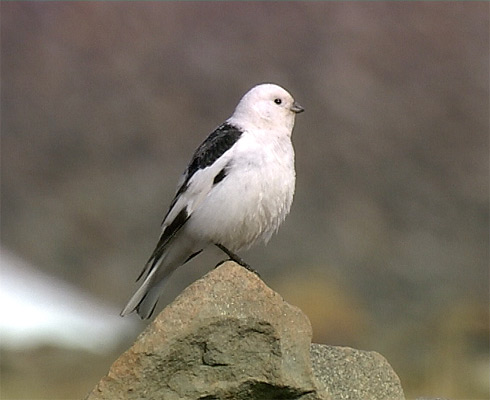- Plectrophenax nivalis
Identification
14–18 cm (5½-7 in)
Breeding
Male
- Black back, legs, wing tips and bill
- Rest of plumage white
Female
- Greyish-black back
- Brown crown and cheeks
- White wing patch
Winter
- Tawny-brown back
- Gingery-buff crown, cheeks and chest patches
- Buff underparts
- Black-tipped yellow bill
Similar species
McKay's Bunting in Alaska is very similar but generally whiter.
Distribution
Found on the tundra of the northern hemisphere in North America and Eurasia. Winter visitor in Britain & Ireland (mostly mid Sep-Apr), mainly from Scandinavia and Greenland, but small numbers breed in Scotland.
Taxonomy
Formerly classified with other buntings in the Emberizidae, Snow Buntings are now placed in a new family, the Calcariidae along with the Longspurs based on a molecular study by Alström et al. (2008).
Subspecies
Four subspecies recognized[1]:
- P. n. nivalis in North America and northern Europe
- P. n. insulae on Iceland > to Faeroes, Shetland Islands and northern Scotland
- P. n. vlasowae in northeast Asia
- P. n. townsendi on western Aleutian islands and some east Siberian island.
Habitat
Breeds on tundra in the north and on high mountain tops with similar habitat further south. Winters largely on sandy and shingle coasts, salt marsh and rough coastal fields.
Behaviour
Diet
The diet includes weed and grass seeds, and insects.
Breeding
It builds an open cup of moss and grass, lined with fine grasses, rootlets, and fur and feathers which is placed well back in cavity in rocks, such as cracks.
The clutch consists of 2-7 creamy white, with variable brown spots and scrawls.
Vocalisation
Song, often in flight display, a short, musical “turee turee tureee turiwee”. Snow Bunting sound clip
References
- Clements, J. F., T. S. Schulenberg, M. J. Iliff, D. Roberson, T. A. Fredericks, B. L. Sullivan, and C. L. Wood. 2018. The eBird/Clements checklist of birds of the world: v2018. Downloaded from http://www.birds.cornell.edu/clementschecklist/download/
- Birdwatchers Pocket Guide ISBN 1-85732-804-3
- Alström P, Olsson U, Lei F, Wang HT, Gao W, Sundberg P (2008). "Phylogeny and classification of the Old World Emberizini (Aves, Passeriformes)". Molecular Phylogenetics and Evolution. 47 (3): 960–73. https://doi.org/10.1016/j.ympev.2007.12.007
- Montgomerie, R. and B. Lyon (2011). Snow Bunting (Plectrophenax nivalis), version 2.0. In The Birds of North America (A. F. Poole, Editor). Cornell Lab of Ornithology, Ithaca, NY, USA. https://doi.org/10.2173/bna.198
- Rising, J. (2018). Snow Bunting (Plectrophenax nivalis). In: del Hoyo, J., Elliott, A., Sargatal, J., Christie, D.A. & de Juana, E. (eds.). Handbook of the Birds of the World Alive. Lynx Edicions, Barcelona. (retrieved from https://www.hbw.com/node/61857 on 2 September 2018).
- Wikipedia contributors. (2018, August 3). Snow bunting. In Wikipedia, The Free Encyclopedia. Retrieved 09:35, September 2, 2018, from https://en.wikipedia.org/w/index.php?title=Snow_bunting&oldid=853238240
Recommended Citation
- BirdForum Opus contributors. (2024) Snow Bunting. In: BirdForum, the forum for wild birds and birding. Retrieved 24 April 2024 from https://www.birdforum.net/opus/Snow_Bunting
External Links
GSearch checked for 2020 platform.1








